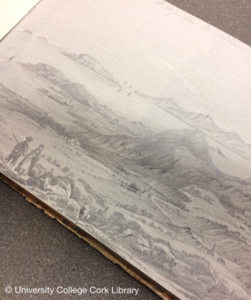Background
The relationship between humans and our environment – people and the world in which we live – is one of the key concerns of the present day.
Coastal environments are reservoirs of personal, cultural, historical and scientific knowledge. Yet in modern debates about the environment, these aspects of our coastlines are often disconnected. This project combines the research skills of cultural historians with those of marine biologists and seeks to bring together many of the different aspects of place.
In doing so, it responds to needs emerging from both humanities and science research. In the case of the humanities, the environmental humanities pose urgent new questions about the scope and scale of human interactions with the environment as represented in literary and other cultural texts. With respect to marine biology, scientists are increasingly aware of the need to deepen and enrich their apprehension of marine environments via a more nuanced sense of the histories and cultures of these storied places.
Aims
The aim of the Deep Maps: West Cork Coastal Cultures project is to develop new ways of thinking about place. We apply these to our endangered marine environment, with the aim of encouraging the ongoing stewardship of Cork’s coast, and Ireland’s maritime heritage.
By researching, analysing and visualising the complex history of cultural interactions with the marine environment in relation to conservation priorities, this project will help to inform decisions that determine the long-term future of West Cork’s unique coastline.
The project goes beyond traditional academic boundaries. Our interdisciplinary team brings together various aspects of past and present (art, culture, history, literature and science). Although we have applied our methodology to the West Cork coast, a further aim of our project is that it can be easily adapted to explore other types of environment and regions.
Scope
The project investigates the biological, cultural, and historical contexts of the south west coast of Ireland from 1700 to 1920, and connects them to the present day marine environment. Our study area stretches along the arc of Roaring Water Bay from Timoleague to Bantry Bay.

Deep Maps Research Area
Sources
Our transdisciplinary approach has required us to draw on a wide range of data sources:
Environmental
We undertook a scientific literature review at the start of our project. After identifying the main issues that threaten the maritime environment today, we examined them in the context of the latest scientific research. We identified five key environmental priorities: fisheries and aquaculture, pollution, climate change, biodiversity and conservation, and policy and legislation. These themes formed the basis of both our local community discussions and the cultural history research.
Local/Personal
It was important for the team to understand local opinions on issues that affect the West Cork coastal environment. Drawing on the themes identified in the literature review we surveyed and interviewed members of West Cork’s coastal communities to understand more about what this rich coastline means to them. We then organised workshops with local community stakeholders, representing areas including the fishing industry, heritage, science, policy and tourism, as well as the general public. We have also engaged with local schools, undertaking artworks, storytelling and surveys. The findings from this strand of our research fed into the maps and timelines we created. They also helped us to connect past to present: cultural history to twenty-first century scientific priorities.
From the start of the project we used social media to engage with the West Cork community and anyone with an interest in this part of Ireland, or our project. We established Facebook, Instagram and Twitter accounts, and used these to share our blog posts, to ask questions and post images from our research trips.
Cultural/Historical

From 1700, when our study begins, there is a rich record of cultural engagement with the West Cork coastline. During the romantic period a diverse range of literary texts were produced (including translations, original poems, tales and novels) as well as a significant body of sketches and paintings of sea and land. The enormous impact of the Great Famine on this coastline drew further attention to the area from writers, journalists, artists and illustrators.
Later in nineteenth century, an important photographic record emerges, capturing information related to reefs, sea cliffs and vegetation; as well as representing such practices as farming, fishing and seal-hunting; and depicting historical processes including land use, work, family life and migration.
We conducted archival research to gain a historical perspective of the West Cork coastline. Sources we consulted included literature, Irish poetry, folklore, estate papers, government reports, historic newspapers, maps, topographical drawings and photographs. The research was conducted in a range of cultural institutions including University College Cork’s Special Collections, Cork City Library and Archive, the National Library of Ireland, the National Photographic Archive, the Royal Irish Academy, and the British Library. This research features in our past and present themes, and in our maps and timelines.
Research Findings
Our findings are incorporated within this website in the form of a scientific literature review, thematic content that links past to present, and interactive timelines and maps. We encourage you to explore our website, and make your own connections between the people, places, and environment of West Cork. We hope that the website will stimulate discourse on themes such as biodiversity, conservation, climate change, fisheries and aquaculture, pollution, and policy and legislation.
>> Project Team

